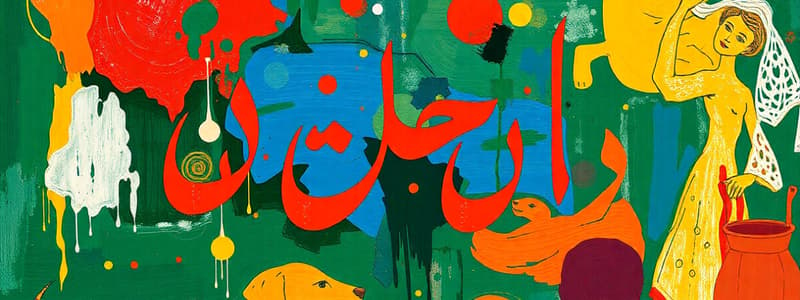Podcast
Questions and Answers
Which of the following languages has NOT had a significant impact on the development of Urdu?
Which of the following languages has NOT had a significant impact on the development of Urdu?
- Turkish
- French (correct)
- Persian
- Arabic
Which of these accurately describes the typical word order in an Urdu sentence?
Which of these accurately describes the typical word order in an Urdu sentence?
- Verb-Subject-Object (VSO)
- Object-Subject-Verb (OSV)
- Subject-Object-Verb (SOV) (correct)
- Subject-Verb-Object (SVO)
How does Urdu's morphology relate to other Indo-Aryan languages?
How does Urdu's morphology relate to other Indo-Aryan languages?
- Urdu morphology is identical to other Indo-Aryan languages, with no notable differences.
- Urdu morphology is completely unique and unrelated to other Indo-Aryan languages.
- Urdu morphology shares some similarities with other Indo-Aryan languages but has distinct features. (correct)
- Urdu morphology completely diverges from other Indo-Aryan languages and is not related.
What is the primary reason for the ease of communication between speakers of Urdu and Hindi?
What is the primary reason for the ease of communication between speakers of Urdu and Hindi?
Which of the following is NOT a characteristic of Urdu's vocabulary?
Which of the following is NOT a characteristic of Urdu's vocabulary?
The statement "Speakers of Urdu and Hindi communicate with remarkable ease, despite the difference in script." highlights which aspect of Urdu?
The statement "Speakers of Urdu and Hindi communicate with remarkable ease, despite the difference in script." highlights which aspect of Urdu?
What is a significant characteristic of Urdu's phonology compared to other Indo-Aryan languages?
What is a significant characteristic of Urdu's phonology compared to other Indo-Aryan languages?
Which of these is NOT true about Urdu dialects?
Which of these is NOT true about Urdu dialects?
Flashcards
Urdu Language
Urdu Language
An Indo-Aryan language spoken mainly in South Asia, national language of Pakistan.
Perso-Arabic Script
Perso-Arabic Script
The writing system used for Urdu, derived from Arabic and Persian scripts.
Khariboli Dialect
Khariboli Dialect
The dialect of Delhi from which Urdu evolved, influencing its development.
Mughal Empire's Influence
Mughal Empire's Influence
Signup and view all the flashcards
Subject-Object-Verb (SOV) Order
Subject-Object-Verb (SOV) Order
Signup and view all the flashcards
Loanwords in Urdu
Loanwords in Urdu
Signup and view all the flashcards
Agglutinative Morphology
Agglutinative Morphology
Signup and view all the flashcards
Mutual Understanding in Dialects
Mutual Understanding in Dialects
Signup and view all the flashcards
Study Notes
Introduction
- Urdu is an Indo-Aryan language spoken primarily in South Asia.
- It is the national language of Pakistan and an official language of India.
- It is written in the Perso-Arabic script.
- Speakers of Urdu and Hindi communicate with remarkable ease, despite the difference in script.
History
- Urdu's roots trace back to the Khariboli dialect of Delhi.
- It evolved over centuries, influenced by Persian, Arabic, and Turkish.
- The development of Urdu was significantly shaped by the Mughal Empire.
- The language gained prominence in the 18th and 19th centuries.
- The Delhi/Hindavi dialect served as the foundation for Urdu's initial form.
Phonology
- Urdu possesses a relatively standard phonetic structure.
- The sounds are similar to other Indo-Aryan languages.
- Urdu vowels are typically similar to those found in other languages of the region, including but not limited to Hindi.
- Consonants are also fairly similar in usage compared to those in Hindi.
Morphology
- Urdu displays Indo-Aryan morphology.
- It exhibits characteristics typically associated with agglutinative and inflectional morphological systems.
- The process of agglutination and inflection allows combining elements semantically, resulting in complex words.
Vocabulary
- Urdu incorporates a significant number of loanwords from other languages, chiefly Persian and Arabic.
- This linguistic influence significantly impacts the vocabulary's richness.
- In addition to its primary Persian and Arabic loanwords, there's also exposure to words of Sanskrit origin.
Syntax
- Urdu's syntax is a mixture influenced by similar languages regionally.
- Subject-object-verb (SOV) word order is common.
- This word order differs slightly from subject-verb-object (SVO) commonly seen in English.
Literature
- Urdu literature has a noteworthy history, marked by substantial poetry and prose.
- Renowned literary figures have made significant contributions to Urdu literature.
- Poetry forms hold a prominent place in Urdu literature, showcasing various styles and themes.
Dialects
- Variations in different regions exist in Urdu, but the differences aren't significant enough to impede mutual understanding.
- The differences in the diverse dialects usually are restricted primarily to vocabulary and intonation.
- While regional variations exist, their magnitude typically doesn't pose a significant barrier to comprehension between speakers of different dialects.
Writing System
- Urdu employs the Perso-Arabic script.
- The script is derived from the Arabic alphabet and modified to suit Urdu's phonetic needs.
- Unlike Devanagari, which is an abugida (a syllabic writing system), the Perso-Arabic script is an alphabet.
Sociolinguistic Aspects
- Urdu plays a vital cultural and linguistic role in the Indian subcontinent.
- Urdu's cultural connections are deeply rooted in the historical and societal context of South Asia.
- It remains a language of literary importance and cultural significance.
- Its importance highlights its impact in socio-cultural contexts of the South Asian region.
Studying That Suits You
Use AI to generate personalized quizzes and flashcards to suit your learning preferences.




